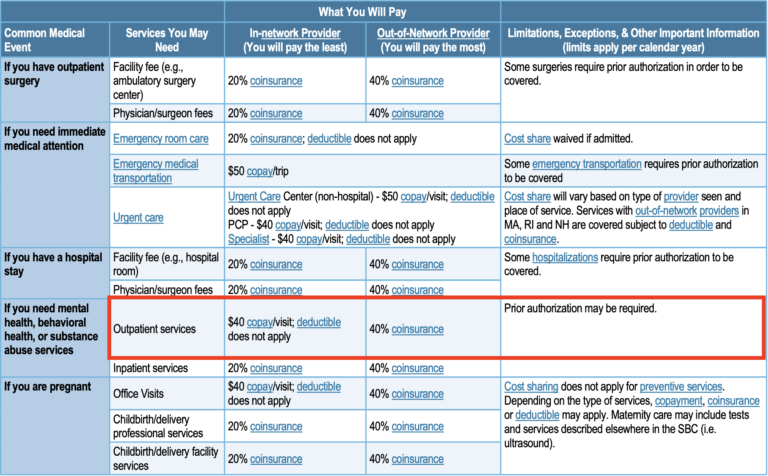Setting Boundaries: Understanding Insurance Coverage Limits
Setting boundaries can be a tricky business, especially when it comes to insurance coverage limits. You want to make sure you’re protected, but how do you know if you have enough coverage? Don’t worry, we’ve got you covered! In this article, we’ll dive deep into the world of insurance coverage limits and help you understand what they mean for you. So grab a cup of coffee, sit back, and let’s unravel the mysteries of setting boundaries in the insurance world.
Insurance coverage limits are like the fences that protect your financial well-being. They determine the maximum amount an insurance company will pay for a covered claim. It’s important to understand these limits because they can have a significant impact on your financial security in the event of an accident or loss. Whether you’re insuring your home, car, or business, knowing the boundaries of your coverage is crucial.
Now, before we jump into the nitty-gritty details, let’s take a moment to appreciate the importance of setting boundaries. Just like a well-built fence around your property, insurance coverage limits provide a sense of security and peace of mind. They ensure that you won’t be left high and dry when facing unexpected expenses. So, let’s break down the concept of insurance coverage limits and empower you to make informed decisions about your insurance needs.

Setting Boundaries: Understanding Insurance Coverage Limits
Insurance coverage limits are an essential aspect of any insurance policy. They determine the maximum amount an insurance company will pay for a covered claim. Understanding these limits is crucial for policyholders to ensure they have adequate protection in case of an unforeseen event. In this article, we will explore the concept of insurance coverage limits and provide valuable insights to help you navigate this aspect of insurance.
What Are Insurance Coverage Limits?
Insurance coverage limits refer to the maximum amount an insurance policy will pay for a covered loss. These limits are set by the insurance company and can vary depending on the type of coverage and the policyholder’s specific needs. For example, in an auto insurance policy, there may be separate coverage limits for bodily injury liability, property damage liability, and personal injury protection.
Understanding your insurance coverage limits is crucial because it determines the level of financial protection you have in case of an accident or loss. If your coverage limits are too low, you may end up having to pay out-of-pocket for damages or injuries that exceed your policy’s limits. On the other hand, if your coverage limits are too high, you may be paying for more coverage than you actually need, resulting in unnecessary expenses.
Types of Insurance Coverage Limits
Insurance policies typically have two types of coverage limits: per occurrence limits and aggregate limits.
Per occurrence limits refer to the maximum amount the insurance company will pay for a single incident or claim. For example, if you have a per occurrence limit of $100,000 on your homeowners insurance policy and experience a covered loss that results in $150,000 worth of damages, the insurance company will only pay up to $100,000, and you will be responsible for the remaining $50,000.
Aggregate limits, on the other hand, refer to the total amount the insurance company will pay for multiple claims during the policy period. For example, if you have an aggregate limit of $500,000 on your general liability insurance and file multiple claims throughout the year that exceed this limit, you will be responsible for any additional costs.
It’s important to review both the per occurrence and aggregate limits of your insurance policy to ensure you have adequate coverage. If you frequently file claims or operate in a high-risk environment, you may want to consider higher limits to protect yourself from potential financial burdens.
Factors That Influence Insurance Coverage Limits
Several factors can influence the insurance coverage limits you need. These factors vary depending on the type of insurance policy and the specific risks associated with your situation. Here are some common factors that can impact your coverage limits:
1. Asset Value: The value of your assets, such as your home, car, or business, can play a significant role in determining the coverage limits you need. Higher asset values often require higher coverage limits to adequately protect your investments.
2. Liability Risks: If you have a higher risk of liability claims, such as in a profession that involves physical activities or interactions with the public, you may need higher liability coverage limits to protect yourself from potential lawsuits.
3. Legal Requirements: Certain types of insurance, such as auto insurance or workers’ compensation insurance, have minimum coverage requirements mandated by law. It’s essential to understand these legal requirements and ensure your coverage limits meet or exceed them.
4. Personal Preferences: Your personal preferences and tolerance for risk also play a role in determining your coverage limits. Some individuals may prefer higher limits to have peace of mind, while others may opt for lower limits to save on premiums.
By considering these factors and working with an experienced insurance agent, you can determine the appropriate coverage limits for your specific needs.
The Importance of Reviewing Your Coverage Limits
Insurance coverage limits are not set in stone. They can be adjusted based on your changing needs and circumstances. It is crucial to review your coverage limits regularly to ensure they align with your current situation. Here are a few reasons why reviewing your coverage limits is essential:
1. Life Changes: Significant life events, such as getting married, having children, or purchasing a new home, can impact your insurance needs. It’s important to update your coverage limits to reflect these changes adequately.
2. Business Growth: If you own a business, its growth and expansion may require higher coverage limits to protect your assets and liabilities. As your business evolves, it’s crucial to reassess your insurance coverage to ensure it keeps up with your growth.
3. Market Conditions: Insurance markets can fluctuate, and coverage limits that were sufficient in the past may no longer offer adequate protection. Regularly reviewing your coverage limits allows you to stay up-to-date with current market conditions and make informed decisions about your insurance coverage.
4. Policy Renewals: When your insurance policy renews, it presents an opportunity to review your coverage limits and make any necessary adjustments. Take the time to assess your needs and discuss any changes with your insurance agent.
In conclusion, insurance coverage limits are a vital aspect of any insurance policy. They determine the maximum amount an insurance company will pay for a covered claim. Understanding your coverage limits and reviewing them regularly ensures you have adequate protection and peace of mind. By considering factors such as asset value, liability risks, legal requirements, and personal preferences, you can determine the appropriate coverage limits for your specific needs. Remember to work with an experienced insurance agent who can guide you through the process and help you make informed decisions about your insurance coverage.
Key Takeaways: Understanding Insurance Coverage Limits
- Insurance coverage limits are the maximum amount an insurance policy will pay for a claim.
- It’s important to review your insurance policy to understand your coverage limits for different types of claims.
- Higher coverage limits provide greater protection, but they may also come with higher premiums.
- Make sure your coverage limits are adequate to protect your assets and cover potential liabilities.
- Consider factors like the value of your assets, potential risks, and your budget when determining coverage limits.
Frequently Asked Questions
Question 1: What are insurance coverage limits?
Insurance coverage limits refer to the maximum amount an insurance policy will pay for a covered claim. These limits are set by the policyholder at the time of purchasing the insurance and can vary depending on the type of coverage and the insurance provider. It’s important to understand these limits to ensure you have adequate coverage in the event of a claim.
For example, if you have an auto insurance policy with a coverage limit of $50,000 for bodily injury liability, this means that your insurance company will pay up to $50,000 for injuries sustained by someone else in an accident caused by you. If the total cost of the injuries exceeds $50,000, you may be personally responsible for the remaining amount.
Question 2: How do insurance coverage limits affect my premium?
Insurance coverage limits can have an impact on your premium, which is the amount you pay for your insurance policy. Generally, higher coverage limits result in higher premiums because the insurance company is taking on more risk by agreeing to pay a larger amount in the event of a claim. On the other hand, lower coverage limits may result in lower premiums, but it’s important to ensure that you have adequate coverage for your needs.
When determining the appropriate coverage limits for your policy, it’s essential to consider factors such as your assets, income, and potential liabilities. While it may be tempting to opt for lower coverage limits to save money on premiums, doing so could leave you financially vulnerable in the event of a claim.
Question 3: Can I change my insurance coverage limits?
Yes, you can typically change your insurance coverage limits. Most insurance policies allow policyholders to adjust their coverage limits at any time, although there may be certain restrictions or requirements depending on the insurance provider. If you want to increase your coverage limits, you may need to provide additional information or undergo a review by the insurance company.
It’s important to regularly review your insurance coverage limits to ensure they align with your current needs and circumstances. Life changes such as buying a new home, starting a business, or acquiring valuable assets may warrant an increase in coverage limits to adequately protect your financial interests.
Question 4: What happens if my claim exceeds my insurance coverage limits?
If your claim exceeds your insurance coverage limits, you may be responsible for paying the remaining amount out of pocket. This is why it’s crucial to carefully consider your coverage limits and ensure that they provide sufficient protection for your assets and potential liabilities.
In some cases, there may be options available to help cover the excess amount. For example, you may have an umbrella insurance policy that provides additional coverage beyond the limits of your primary insurance policies. It’s always best to consult with your insurance provider to understand your options and make informed decisions regarding your coverage limits.
Question 5: How can I determine the right insurance coverage limits for me?
Determining the right insurance coverage limits for you requires careful consideration of your individual circumstances. Factors to consider include your assets, income, potential liabilities, and personal risk tolerance.
A good starting point is to evaluate your current financial situation and assess the potential risks you may face. For example, if you have significant assets or a high-income level, you may want to consider higher coverage limits to protect your wealth. On the other hand, if you have minimal assets and a lower income, you may be able to opt for lower coverage limits.
It’s also a good idea to consult with an insurance professional who can assess your specific needs and provide guidance on the appropriate coverage limits. They can help you understand the potential risks you may face and ensure that you have adequate protection in place.

Personal Boundaries Explained – Setting The Emotional Boundaries You Need | BetterHelp
Final Summary: Understanding Insurance Coverage Limits
Navigating insurance coverage limits can be a complex task, but it’s essential for protecting your assets and ensuring peace of mind. By setting clear boundaries with your insurance policy, you can safeguard yourself against unexpected risks and potential financial hardships.
When it comes to understanding insurance coverage limits, it’s crucial to familiarize yourself with the specific terms and conditions outlined in your policy. Take the time to review the fine print, ask questions, and seek clarification from your insurance provider if needed. This will help you gain a comprehensive understanding of what is covered, what is not, and the limits that apply.
Remember, insurance coverage limits are designed to protect you up to a certain amount in the event of a claim. It’s important to assess your needs and select coverage limits that align with your assets and potential risks. Don’t underestimate the value of your belongings or the potential costs of liability claims. By properly setting boundaries and choosing appropriate coverage limits, you can safeguard yourself against unforeseen circumstances that may arise.
In conclusion, understanding insurance coverage limits is crucial for ensuring comprehensive protection and financial security. By familiarizing yourself with the terms and conditions of your policy, setting appropriate boundaries, and selecting coverage limits that align with your needs, you can navigate the world of insurance with confidence. Remember, it’s always better to be prepared and protected than to face unexpected challenges without adequate coverage. So, take the time to assess your insurance needs, review your









